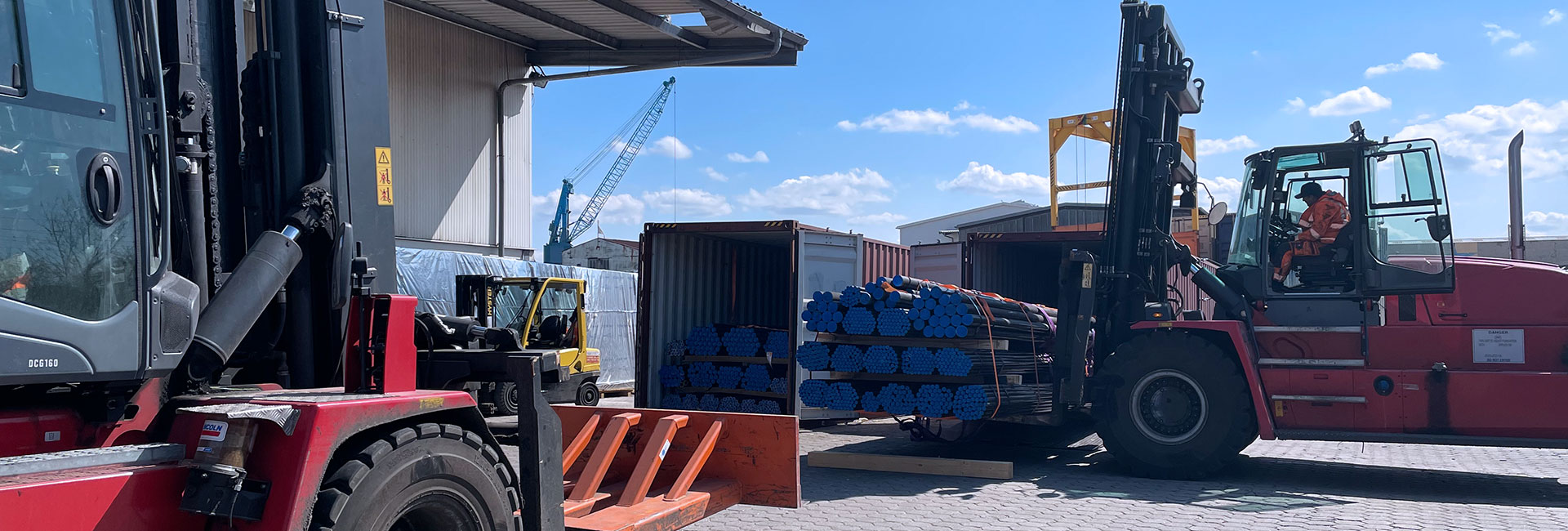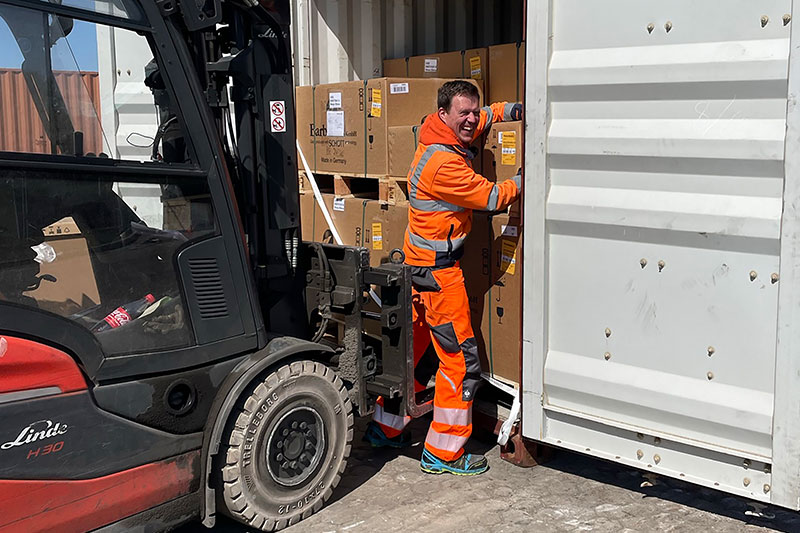
What exactly this should look like varies from time to time. Above all, it depends on the nature of the goods – after all, not every type of load fits on pallets or in boxes and can be stowed in a form-fit manner.
The Port of Hamburg offers various specialists in securing cargo. PCH – Packing Center Hamburg is one of these. At its Wollkämmereistrasse site, every day containers are packed with all sorts of items for export, and unloaded from others as imports. Apart from packing groupage, FCL and out-of-gauge containers, the experts here also see to the seaworthy packing of freight.
In particular, any freight marked as hazardous naturally needs to be stored, packed and secured separately. Yet even with normal freight, cargo security is of paramount importance before it can proceed to further transport aboard seagoing vessels. As a rule, most of the freight has already been stowed on pallets or in wooden crates in such a way that the precise contents are neither known or of relevance for being secured in the container. Such cargo belongs in the LCL – ‘Less than Container Load’ – category. Here a whole variety of items from different shippers congregate in one container. These are delivered individually and then consolidated in the packing center.
A second variant of containerized cargo consists of complete shipments from one shipper. This can also consist of pallets and crates. Yet securing cargo for some objects – such as building elements, vehicles or machines – requires a special technique. On occasion, such freight will invariably call for the maximum capacity or dimensions of a 40-ft standard container.
In seaborne transport, a distinction is made between containerized cargo of two different types. The abbreviation LCL stands for Less than Container Load and describes the combination in a single container of general cargoes from different shippers. As a rule, FCL – Full Container Load – freight is project cargo from a single shippers, filling an entire container.
The CTU Code of the IMO – International Maritime Organisation and the ILO – International Labour Organisation lays down the requirements and criteria for securing cargoes. This replaced the previous container packing guidelines in 1997. Standard containers are known as ISO containers. These are of normed dimensions, facilitating container stacking and handling at terminals.
Containers for transport by sea are equipped in advance with devices for securing cargo. These consists of lashing bars on the corner posts and the roofs and longitudinal members; lashing rings mounted in the floor; ‘corrugated’ steel sidewalls; and ideally, a wooden container floor. The appropriate cargo lashing devices can then be secured at these points.
From box to box, the differing characteristics of the freight items poses a fresh challenge for the packing experts. “It’s rather like playing Tetris,” is PCH CEO Ole Brügmann’s imaginative way of describing the process of stowing LCL cargo in a standard container. The most vital principle here is always: Cargo inside the container must be secured on all sides against slipping. Securing on the door side is especially vital. Fundamentally, packing commences with the largest elements. Stowage must be tight-fit. “The less filler material required, the better,’ explains Matthias Biel of PCH. Wherever crates and pallets cannot be stowed tight-fit to each other, use is usually made of filler materials. The gap between objects packed may not exceed 15 centimetres. When the gap between pallets or crates is greater, then airbags and/or wedge timbers can provide added security.
“The aids and methods for securing LCL cargo are always the same,” explains Ole Brügmann. Among those available are air-filled cushions, chipboard panels of various thicknesses, and wedge timber. All wooden elements bear an iPPC stamp. Both the use and the quality of materials must be in accordance with the rules. For protecting native woodlands and preventing intrusion of pests and mould, the IPPC – International Plant Protection Convention – lays down the appropriate rules for handling timber.
Prior to closure of the containers, lashing material frequently serves to secure cargo. Lashing points on the corner pillars as well as the container floor/roof supply the lashing points. ‘Lashing’ is the term for the process of fastening down and tying up the cargo to prevent it from slipping. Apart from lashing in the container, lashing down is subsequently essential on the seagoing vessel.
“The aids and methods for securing LCL cargo are always the same,” explains Ole Brügmann. Among those available are air-filled cushions, chipboard panels of various thicknesses, and wedge timber. All wooden elements bear an iPPC stamp. Both the use and the quality of materials must be in accordance with the rules. For protecting native woodlands and preventing intrusion of pests and mould, the IPPC – International Plant Protection Convention – lays down the appropriate rules for handling timber.

Crates and pallets can normally be tight-fit stacked and secured easily. Yet not every cargo is quadratic. Bundles of steel pipes weighing almost 23 tons have arrived at the WSG – Grasbrook Cargo Handling Station. From a single shipper, these are due for containerized transport by sea. The bundles of pipes accordingly constitute an FCL shipment. “For special cargo like these bundles of pipes, prior to any stowage we need to prepare a container,” explains Tomas Orsolic, Works Manager for WSG.
Specifically, this case involves both a great weight making the container almost fully loaded, and also special length dimensions. The container is twelve metres long, the bundles only roughly between seven and eight metres. Tomas and his colleagues therefore shorten the interior of the box with a reinforced interim wall. This ensures that for container handling at the terminal, the pivotal point of the project cargo will lie and remain in its centre.
The pipe bundle itself is held together with belts and stowed in the container by two forklifts. Whereas the crates and pallets in the LCL shipments can readily be loaded by a single forklift driver, this type of project cargo calls for teamwork. The lashed pipe bundles are finally pushed into the open container with the aid of a wooden sliding floor. This simplifies all pushing/positioning in the container and also prevents any damage to the container floor itself.
Perfect positioning of non-normed cargo like this is not always achieved at once. For an LCL shipment, similar package dimensions and characteristics primarily call for a practiced eye in correctly arranging/ aligning the contents of a container. Unusual project cargo calls in addition for cooperation and precise consultation on stowage coordination. These Hamburgian packing experts rely on expertise, precision in observing the regulations, and the team’s sense of responsibility. “With every shipment arriving here, we learn something new. What finally matter are experience and good cooperation. Here we have both,” says Ole Brügmann.
Situated on Wollkämmereistrasse in the heart of the Port of Hamburg, PCH – Packing Center Hamburg was founded in 1988. Its core business is in unloading import groupage containers and loading those for export. PCH also handles FCL and out-of-gauge containers of up to 45 tons. These packing experts also offer seaworthy cargo packing.
Freight Packing Station Grasbrook has operated in the Port of Hamburg as an independent operation in the Port of Hamburg since 1996. The new facility on Schilfstrasse was added in 2005. This site facilitates a still better transport link within the – former – freeport, offering a private siding and a shed for hazardous goods. WSG was enlarged with the purchase of additional land in 2021. Facilitating covered hall storage of heavy cargoes, among other equipment WSG now has a 30-ton port crane.